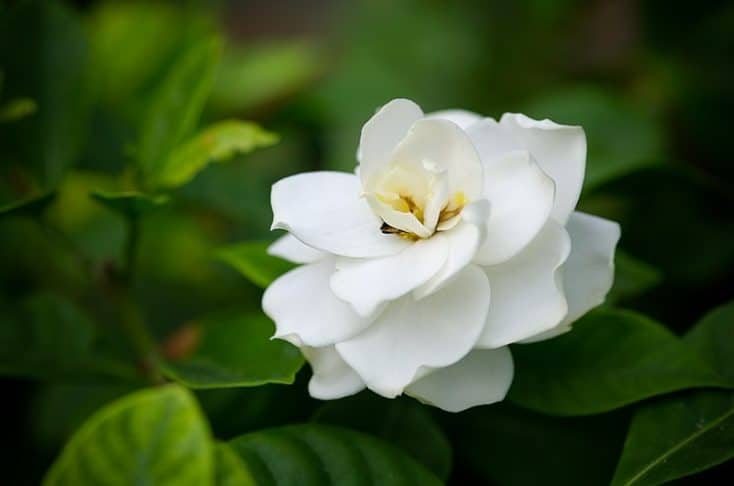Gardenias are well known for their amazing fragrance and beautiful flowers. They’re often considered to be difficult plants to grow indoors, but if you provide gardenias with what they need to thrive, they’ll grow beautifully in your home.
How to grow gardenias indoors?
- Provide as much indirect sunlight as possible.
- Use a pot with good drainage and soil with the right acidity.
- Ideal daytime temperatures of 65 to 70° F (18.3 to 21.2° C).
- Provide a tropical, humid environment.
- Feed frequently with 15-15-15 fertilizer.
Here’s everything you need to know about how to grow gardenias indoors, including how much light these plants need, how to water them, and what to do if they start dropping leaves.
Why Are Gardenias So Popular?
Both indoor and outdoor gardeners love gardenias. They’re considered to be a flower of “love, purity, and sweetness”, which is why you often see gardenias in bouquets and on tables at weddings.
The leaves are dark green and glossy, the perfect backdrop for the fragrant, creamy-white flowers. When in bloom, the scent of your gardenia will fill the room with a sweet floral aroma that will instantly brighten your day.
Indoor gardenias have a height and spread of 2 to 6 feet (60cm to 2m). When growing conditions are ideal, these houseplants will bloom during the summer and autumn months.
Gardenias belong to the Rubiaceae family – their botanical name is Gardenia jasminoides. Native to China and Japan, gardenias are usually grown outdoors in warmer, humid climates. Bring them indoors and provide them with the same growing conditions and you can expect your gardenia to thrive and have long-lasting blooms.
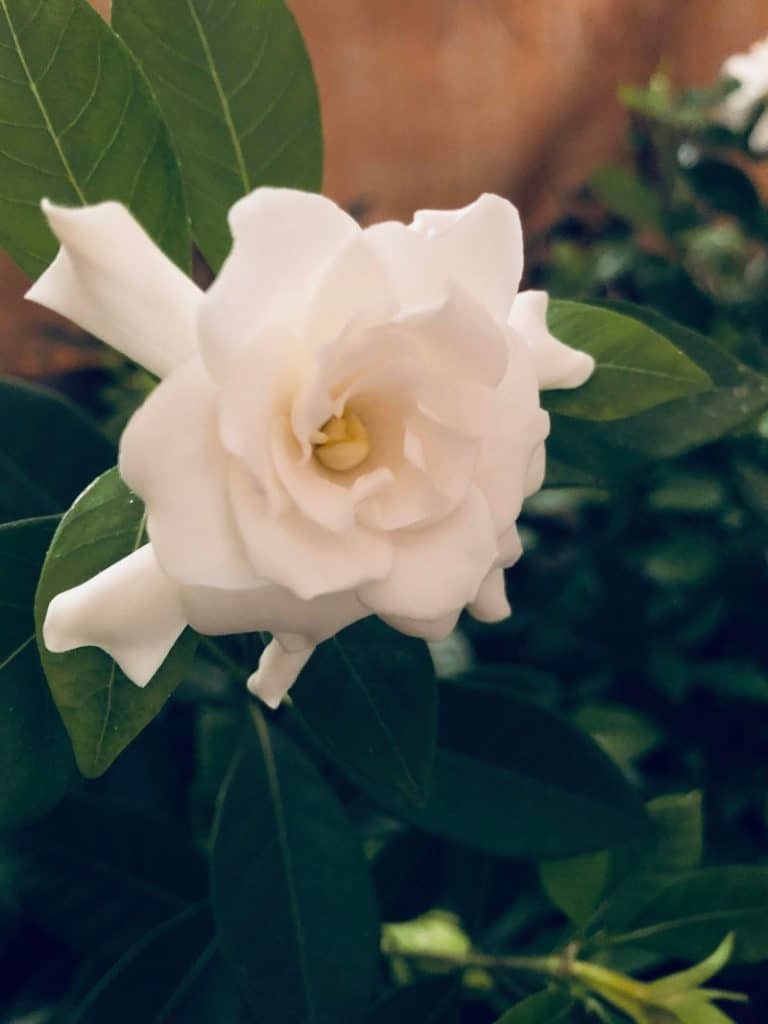
Ideal Light Conditions For Gardenias
Gardenias need a lot of light, at least 6 to 8 hours each day, so choose the sunniest spot in your home for these plants. Windows that have a southeast exposure are a good choice, with the morning sun and sun throughout the day.
Windows facing southwest can often be too hot in summer months so don’t put the plant directly on windowsills. Heat and direct sunlight may scorch the plant and cause the leaves to wilt, even if the soil is moist.
As the seasons change, you’ll want to move your gardenia from one location to another in your home so that it gets adequate light. During the winter months, that southwest window that’s too hot in the summer will become ideal in the colder season when there are fewer daylight hours.
If you live in an area where winters are bleak with more gray days than sun, consider investing in grow lights to help your gardenia stay healthy until spring arrives.
Best Location For Gardenia Plants
It’s not just sunlight your gardenia needs to be happy – it also needs the perfect location in your home. Choose an area that’s well ventilated with circulating air without there being any drafts. During colder weather be sure not to place the plant where it can get direct heat from a furnace or other heat source.
Other than moving your gardenia in the winter to a location where it gets more light, try not to move it around too much. Gardenias are more sensitive than other houseplants and once they adapt to a particular location, they may start to drop leaves, buds, and flowers if you move them too often.
When it comes to location, bathrooms can be a good choice if there’s a window that provides enough light. Steam from showers and baths can provide just the right amount of humidity, making for the perfect tropical environment.
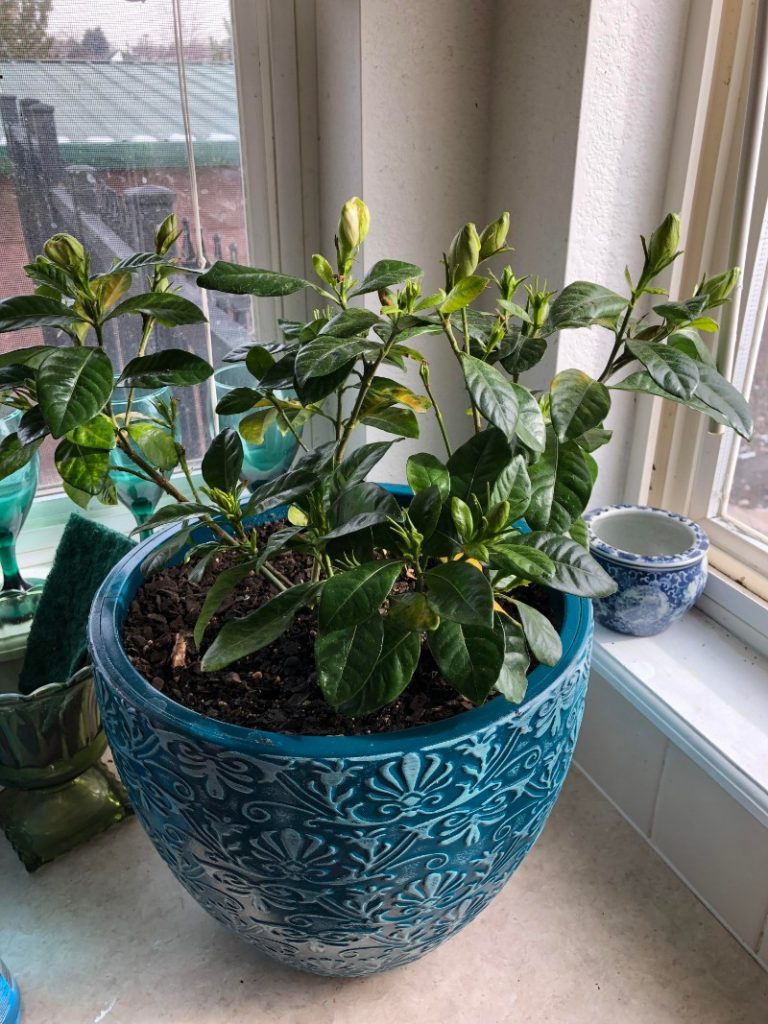
What Type Of Pot Is Best For Your Gardenia?
Gardenias do well in a variety of pots – terra cotta, clay, plastic, or ceramic all work well so long as there are holes at the bottom of the pot for adequate drainage. Terra cotta and clay pots are my first choice as they allow the roots of the gardenia to stay moist longer than other types of pots.
No matter what type of pot you choose, gardenias prefer pots that drain well so that water doesn’t pool around the roots and in the bottom of the pot. You want the water to flow evenly through the soil, down to the roots, and out through the drainage holes. Drainage holes also allow for good air circulation through the roots of the plant, keeping them healthy.
Best Soil For Gardenias
Use good quality potting soil that’s made with a mix of coarse sand and peat moss. Soil should also contain a small amount of acidic compost, otherwise known as “ericaceous” compost. This will help to keep the soil at the right acidic level for gardenias.
You can buy ericaceous soil at any gardening store or you can make yourself. If making your own, mix together 20 percent perlite, 10 percent regular garden potting soil, 10 percent compost, and 10 percent coarse sand. Another option when it comes to soil is to buy a mix that’s intended for rhododendrons as this plant requires the same soil conditions as gardenias.
Gardenias also like a bit of mulch in the pot – on top of the potting soil add a layer of organic mulch. This is a great way to keep the roots moist without them becoming too wet. Mulch can also help increase the humidity level.
If you purchased your potted gardenia from a garden center or florist, it’s most likely planted in the right type of soil. Be sure to ask before you bring the plant home.
Importance Of Soil pH
Gardenias need acidic soil to grow successfully. The pH level of the soil should be between 4.5 and 6.0. If the soil is too alkaline the leaves on your gardenia may start to yellow and fall off, and the plant most likely won’t bloom.
The pH level of soil naturally changes over time as you water and fertilize the plant, so you’ll need to be sure to keep the acidity of soil at the right level. Before you adjust the acid level of the soil, you’ll need to know what the pH level is. You can do this by using a soil pH test kit, available in gardening centers.
If you need to increase the acidity of the soil you can water your gardenia once a month with diluted vinegar or with leftover tea. Some indoor gardeners increase acidity in the soil by adding a scattering of coffee grounds to the top of the soil before watering. Use organic coffee grounds if possible.

Gardenias Love Humidity
Like many tropical plants, gardenias love and need humidity. Mist your gardenia every day to add humidity to the plant’s environment. If you can, avoid misting directly onto the buds and flowers as this may cause them to discolor.
During winter, when you’re heating your home, mist the plant two to three times every day. If you misted earlier in the day, check to see if the leaves are still wet before misting again.
Another way to provide more humidity for your gardenia in the winter months is to put a humidifier nearby. Or group your gardenia together with other potted gardenias or houseplants to keep up the humidity level.
Here’s an easy tip to maintain humidity for gardenias: Place about an inch of coarse gravel into a drainage dish. Pour water into the dish, covering the gravel about half way up with water. Place your potted gardenia on top of the gravel, making sure the water doesn’t touch the bottom of the pot.
Using this method is ideal for those cooler months when you’re heating your home with electric or gas heat. Gardenias don’t like this dry heat and will often start to drop leaves if the air isn’t humid enough.
A word of caution on misting – while gardenias like misting and thrive on humidity, too much moisture can also cause problems such as fungal growth on the leaves. This is why good air ventilation is essential when you grow gardenias indoors. Circulating air will help dry the plant, preventing moisture from pooling on the leaves where it can cause problems.
How To Water Gardenias
You’ll need to take a lot of care when watering your gardenia. Water just enough so that the soil stays evenly moist. Don’t over water or the soil can easily become waterlogged or soggy.
Gardenias that are overwatered will often develop brown spots on their leaves. Other hazards of overwatering include buds that won’t fully open and root rot. Waterlogged soil is one of the quickest ways to permanently damage gardenias.
At the same time, don’t let your gardenia dry out completely or the leaves of the plant may start to drop off. As well, once the roots become too dry it can be hard to revive them. As with over watering, not watering enough is a sure way to kill your gardenia!
As a basic rule, check before watering. Stick your finger into the soil, about two inches deep. If the soil still feels moist, it’s not yet time to water your gardenia. Or buy a soil moisture reader for indoor plants that will help you determine if the plant needs watering.
During the winter months, when the plant isn’t growing, you can water a little less, letting the plant dry out a bit more between watering.
Always use water that’s been standing at room temperature. Cold water can shock and damage the plant. I keep water in a watering can so it’s always at the right temperature, filling up after the last watering in preparation for the next.
Gardenia Temperature Needs
Ideally, grow gardenias indoors in room temperatures between 65 and 70° F (18.3 to 21.2° C) during the day and 55 to 65° F(12.8 to 18.3° C) during the night. If the temperature is above 70° F (21.2° C) the buds on the plant may drop off.
The reason for low night temperatures is so the buds on the plant are able to set so the gardenia will bloom again in the spring. The plant will also need the longer dark days of winter as encouragement to flower in the late spring.
If possible, avoid sudden temperature drops. As I mentioned previously, gardenias are sensitive and quick temperature changes can cause leaves and flowers to fall.
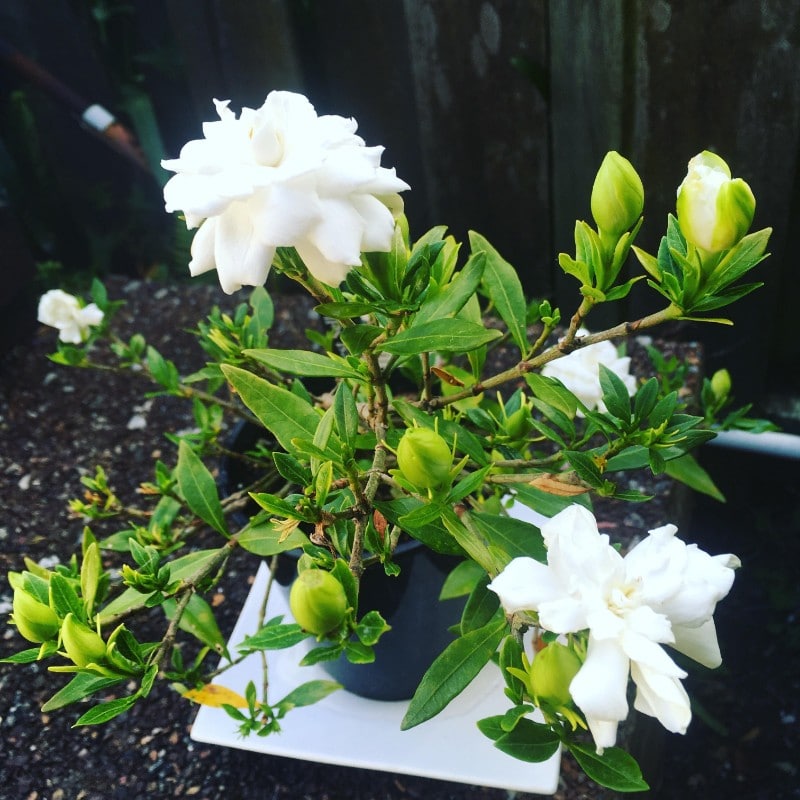
Do Gardenias Need Pruning
Most of the time your gardenia will keep a nice shape and grow uniformly in size. To help the plant keeps its shape, clip off any stems that start to grow too long. If you want your gardenia to bloom, you’ll need to carefully prune it.
The buds and flowers will only form on the new stem growth, so old stems that are dry and woody will need to be removed. This will encourage new stems to start growing so that your gardenia will flower again.
During the dormant months when little to no plant growth is happening, pinch the tips of the stem just below the first leaf to encourage the plant to grow thicker and bushier when it does start growing again.
As well during the winter months, whenever you see stems that are damaged or dead use sharp scissors or pruning shears to remove them. This will keep the plant healthy even when it’s not growing. And keep it looking pretty as well.
Do Gardenias Need Fertilizer?
Feeding your gardenia can help it thrive in indoor conditions. During the spring and summer when the plant is in full growth mode, fertilize your gardenia every two weeks.
Choose a water soluble fertilizer that’s made for plants that need more acidity than other plants. To keep from adding too much fertilizer, dilute the solution to about half of the strength that’s recommended. It’s better to under-fertilize than give the plant too much.
Plant and garden centers will have a wide selection of fertilizers to choose from. The best ratio of fertilizer for gardenias is 15-15-15: nitrogen, phosphorus, and potassium.
During the fall and winter months, when your gardenia is in its dormant phase, you’ll only need to feed the plant once a month.
Propagating Gardenias
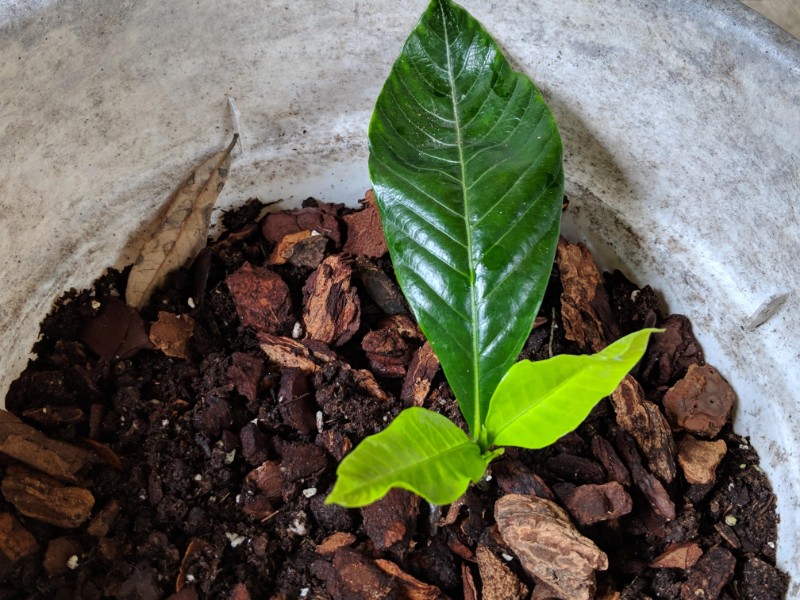
Want more beautiful gardenias in your home? These plants can easily be propagated from stem cuttings. During the spring and summer when you prune your gardenia, keep some of the larger clippings to start new little plants. Place each stem in a rooting medium made of half peat moss and half perlite, and water just to moisten.
Once rooted, plant each stem in its own pot, using the right soil to get the correct pH balance. With care and patience, you’ll soon have more blooming gardenias to display around your home…or to give away as a gift.
When To Repot
Indoor gardenias are slow growers and don’t often outgrow their pots. You’ll only need to repot when the roots of the plant are starting to fill the pot and grow out through the drainage holes. If you should need to repot, do so in the late spring as the plant is coming out of its dormant state.
Common Pests and Diseases
If you are going to grow gardenias indoors, at some point you will have to deal with pests that damage its leaves, buds, and flowers. Some of these pests include aphids, spider mites, and mealy bugs.
Aphids are by far the most common pest for any houseplant. You can deter aphids by using a solution of one part water with one part of mild liquid soap. For spider mites and mealy bugs you can use the same solution of water and soap – or use neem oil, which is made from the seeds and fruits of the neem tree, also known as Indian Lilac.
If possible, only treat the leaves for pests, avoiding the blooms or buds to prevent damage.
Gardenias are also prone to disease, such as bacterial and fungal diseases that are caused by high humidity. You can safeguard against disease by making sure the plant is located in an area where there’s good air circulation.
A Note On Blooming Gardenias
When you first bring home your gardenia, chances are it will be nicely in bloom. If you want your gardenia to bloom again in spring and summer, you’ll need to make sure that all of the requirements I’ve gone over here are met.
Related Questions
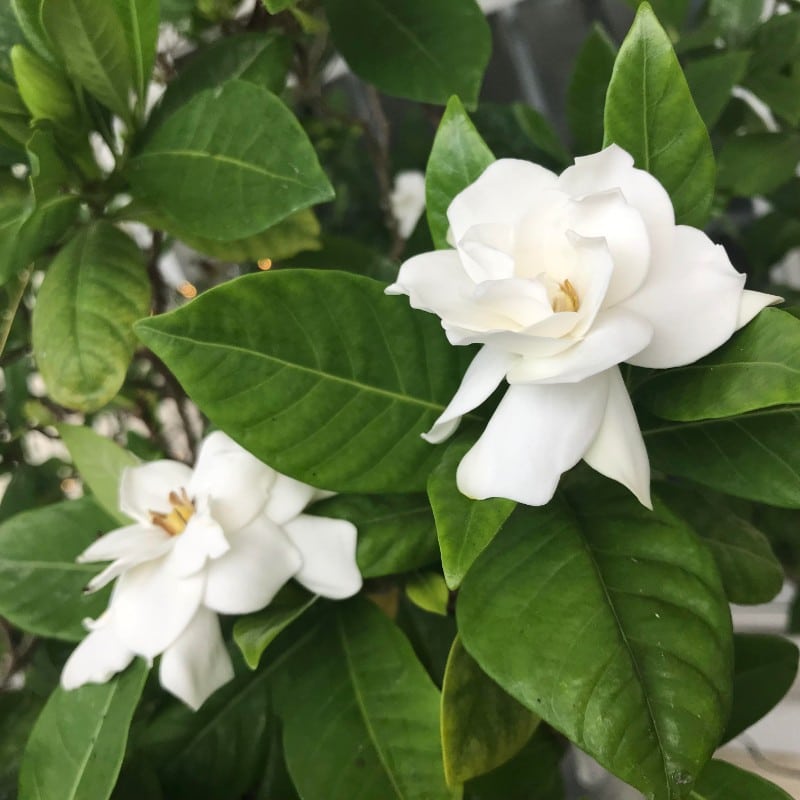
Can I take my gardenia outside in warm weather?
You can take your gardenia outside in the summer months, keeping the plant in a shady location. Bring the plant back indoors when the temperature falls below 60°F (15° C).
The buds and leaves are falling off my gardenia. What am I doing wrong?
One of the main causes for gardenias to drop buds and leaves is not enough light. Move the plant to a window location where it will get more daylight hours.
Why are the leaves on my gardenia turning yellow?
When leaves on gardenias turn yellow it’s a sign that the plant isn’t getting enough fertilizer. Feed the plant with fertilizer that’s meant for plants that need acidity.

